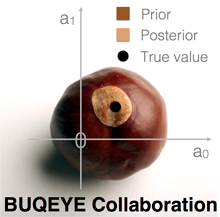About this Jupyter Book#
About these lecture notes#
These lecture were originally authored by Dick Furnstahl and released under a Creative Commons BY-NC license. The book format is powered by Jupyter Book. They have been modified by Daniel Phillips.
Open an issue
If you find a problem or have a suggestion when using this Jupyter Book (on physics, statistics, python, or formatting), from any page go under the github icon  at the top-middle-right and select “open issue” (you may want to open in a new tab by right-clicking on “open issue”). This will take you to the Issues section of the Github repository for the book. You can either use the title already there or write your own, and then describe in the bigger box your problem or suggestion.
at the top-middle-right and select “open issue” (you may want to open in a new tab by right-clicking on “open issue”). This will take you to the Issues section of the Github repository for the book. You can either use the title already there or write your own, and then describe in the bigger box your problem or suggestion.
Acknowledgements#
These notes originated from an intensive three-week summer school course taught at the University of York in 2019 by Christian Forssén, Dick Furnstahl, and Daniel Phillips as part of the TALENT initiative. The first version of the notes were used to teach a graduate course at The Ohio State University in Autumn, 2019. Daniel Phillips revised the notes when he taught the course in Fall 2023. Phillips and Furnstahl acknowledge the following colleagues, who played a key role in shaping this course and their understanding of Bayesian statistics.
Prof. Christian Forssén, Chalmers
Prof. Morten Hjorth-Jensen, Oslo University and Michigan State University
Dr. Jordan Melendez, Ohio State University and Root Insurance
Prof. Matt Plumlee, Northwestern University and Amazon
Prof. Matt Pratola, Ohio State University
Prof. Frederi Viens, Michigan State University
Dr. Sarah Wesolowski, University of Pennsylvania
The development of this course also would not have been possible without the knowledge gained through the study of several excellent textbooks, most of which are listed as recommended course literature. Here is a short list of those references that I have found particularly useful as a physicist learning Bayesian statistics and machine learning:
[GCS+13] Andrew Gelman et al., “Bayesian Data Analysis, Third Edition”, Chapman & Hall/CRC Texts in Statistical Science (2013).
[Gre05] Phil Gregory, “Bayesian Logical Data Analysis for the Physical Sciences”, Cambridge University Press (2005).
[Jay03] E. T. Jaynes, “Probability Theory: The Logic of Science”, Cambridge University Press (2003).
[Mac03] David J.C. MacKay, “Information Theory, Inference, and Learning Algorithms”, Cambridge University Press (2005).
[SS06] D.S. Sivia with J. Skilling, “Data Analysis : A Bayesian Tutorial”, Oxford University Press (2006).
The presentation and examples in the book by Sivia have been the underlying guide for much of the course. Other valuable references can be found in the Bibliography.
Brief guide to online Jupyter Book features#
A clickable high-level table of contents (TOC) is available in the panel at the left of each page. (You can close this panel with the left arrow at the top-left-middle of the page or open it with the contents icon at the upper left.)
The “Search this book…” box just below the title in the TOC panel is a great tool. Try it! (And enhancements are expected in the near future as the Jupyter Book project matures.)
For each section that has subsections, a clickable table of contents appears in the rightmost panel.
On pages that are not generated from Jupyter notebooks, the three icons at the top-middle-right will put you into full-screen mode; take you to the github repository for the book or let you open an issue (see the top of this page); or show you the markdown source (.md) of the page or generate a pdf version of the page.
On pages generated from Jupyter notebooks, there is an additional icon at the top-middle-right (leftmost), which enables you to run the notebook on a cloud server using Binder. When running on Binder, be patient; it may take a while to generate the page if the environment needs to be created from scratch (in general it is cached, so it will be much faster if others have been recently using notebooks from the repository).
